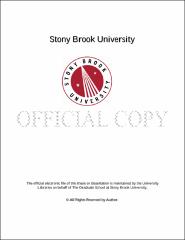| dc.identifier.uri | http://hdl.handle.net/11401/76864 | |
| dc.description.sponsorship | This work is sponsored by the Stony Brook University Graduate School in compliance with the requirements for completion of degree. | en_US |
| dc.format | Monograph | |
| dc.format.medium | Electronic Resource | en_US |
| dc.language.iso | en_US | |
| dc.publisher | The Graduate School, Stony Brook University: Stony Brook, NY. | |
| dc.type | Thesis | |
| dcterms.abstract | Traditional Chinese theatre is unique. Unlike its distinct stage elements with apparent Eastern features, the special role of audience participation in traditional Chinese theatre is less conspicu-ous and, to some, may seem disordered; however, underneath, the logic of audience participation suggests a theatrical communication and a performer-audience relationship that is completely different from the theatrical traditions of the Western world. There is an explosion of interest in the role of the audience among twentieth and twenty-first century theatre practitioners in the Western world. To these experimental theatre artists, forming a non-traditional performer-audience relationship is often an approach to show their beliefs of the essential definition of theatre and performance, as well as their beliefs in theatre’s potential to influence, impact and interact with the real world. Naturally some questions would rise when we make the comparison: what principles do the old instinctively developed traditions share with the relatively new and self-conscious experiments? What are the differences between them and what do they suggest to us about the future of audience participation and theatrical experience? | |
| dcterms.abstract | Traditional Chinese theatre is unique. Unlike its distinct stage elements with apparent Eastern features, the special role of audience participation in traditional Chinese theatre is less conspicu-ous and, to some, may seem disordered; however, underneath, the logic of audience participation suggests a theatrical communication and a performer-audience relationship that is completely different from the theatrical traditions of the Western world. There is an explosion of interest in the role of the audience among twentieth and twenty-first century theatre practitioners in the Western world. To these experimental theatre artists, forming a non-traditional performer-audience relationship is often an approach to show their beliefs of the essential definition of theatre and performance, as well as their beliefs in theatre’s potential to influence, impact and interact with the real world. Naturally some questions would rise when we make the comparison: what principles do the old instinctively developed traditions share with the relatively new and self-conscious experiments? What are the differences between them and what do they suggest to us about the future of audience participation and theatrical experience? | |
| dcterms.available | 2017-09-20T16:51:21Z | |
| dcterms.contributor | Ashizawa, Izumi | en_US |
| dcterms.contributor | Marsh, Steve | en_US |
| dcterms.creator | Wu, Zifei | |
| dcterms.dateAccepted | 2017-09-20T16:51:21Z | |
| dcterms.dateSubmitted | 2017-09-20T16:51:21Z | |
| dcterms.description | Department of Theatre Arts | en_US |
| dcterms.extent | 74 pg. | en_US |
| dcterms.format | Application/PDF | en_US |
| dcterms.format | Monograph | |
| dcterms.identifier | http://hdl.handle.net/11401/76864 | |
| dcterms.issued | 2016-12-01 | |
| dcterms.language | en_US | |
| dcterms.provenance | Made available in DSpace on 2017-09-20T16:51:21Z (GMT). No. of bitstreams: 1
Wu_grad.sunysb_0771M_12879.pdf: 19579052 bytes, checksum: 1fd8a544033c7555386abdafd7b5e81c (MD5)
Previous issue date: 1 | en |
| dcterms.publisher | The Graduate School, Stony Brook University: Stony Brook, NY. | |
| dcterms.subject | Audience Participation, Chinese Opera, Traditional Chinese Theatre | |
| dcterms.subject | Theater | |
| dcterms.title | Audience Participation in Traditional Chinese Theatre | |
| dcterms.type | Thesis | |

